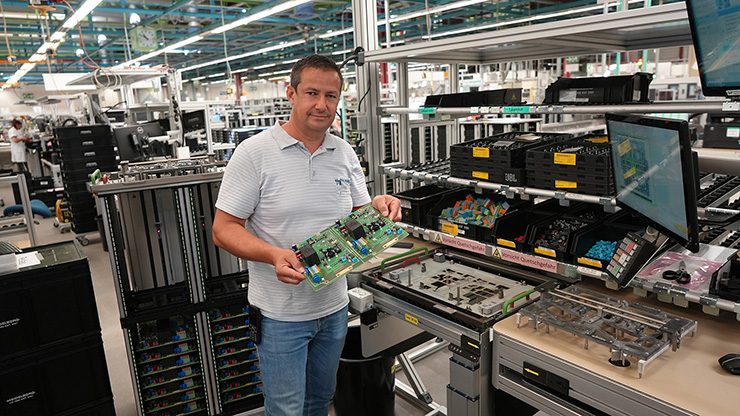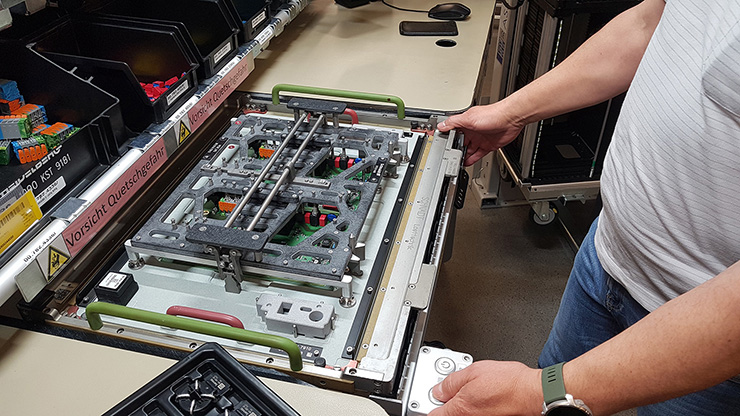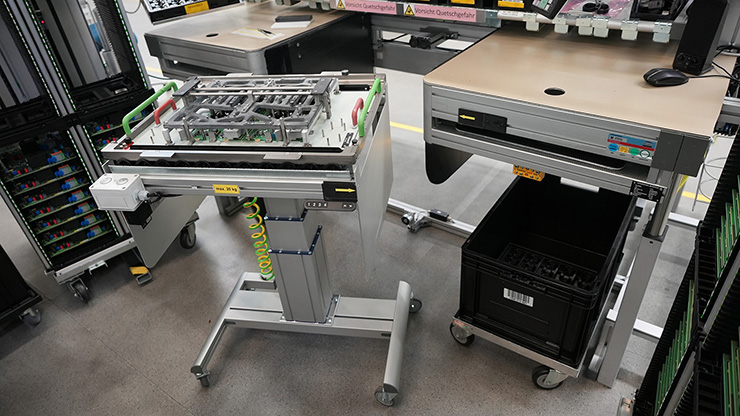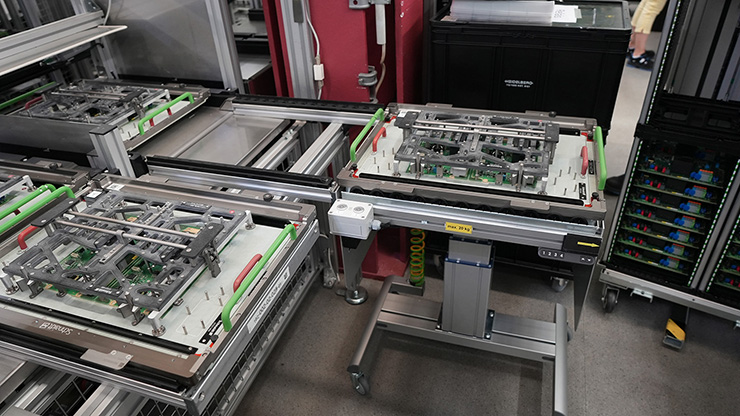- Products
- Solutions
- Service
- Company
MiniTec has been a partner of HEIDELBERG for many years, a leading manufacturer of printing presses and now also of wallboxes for electric vehicles. In addition to the profile system, workstations and ergonomic lifting equipment are also used in production.
For more than 170 years, Heidelberger Druckmaschinen AG has been a reliable partner for the global printing industry. But it is also looking around for interesting new fields of activity and growth markets. For example, HEIDELBERG's expertise in power electronics in the e-mobility market has now established it as a leading supplier of charging systems in Germany.
The company initially started in this external business field with charging electronics for charging cables from other manufacturers. Gradually, the company began to develop its own charging systems, such as a wallbox for private use, and introduced corresponding products to the market.
The printed circuit boards with the control logic for the wallboxes are manufactured in HEIDELBERG's electronics production facility. Here, the company also develops and designs the complete electronic inner workings for its presses.
The boards are assembled mainly by machine, but also partly by hand. Gunther Kullmann, the work planner responsible at HEIDELBERG, explains: "There are two different production areas. One is SMD assembly, which involves all the small parts - this is done by automatic machines. But then there are components that can't be handled by machines, and this is where employees are still used to assemble the boards."

Do you have any questions or would you like to learn more about assembly lines? Then please feel free to contact us!
The health of its employees is very important to HEIDELBERG, and the company attaches great importance to ergonomics in the workplace. Kullmann: "Ergonomics is an important topic for occupational health and safety, and a company also has a duty of care for its employees. That's why, for example, all of our tables are height-adjustable throughout production, which our employees really appreciate."
Improving ergonomics was also the issue in PCB assembly, according to Kullmann: "The background to this was that we have around 240 handling operations per shift, which involve lifting, carrying, turning and setting down a workpiece weighing around 9 kg. Until now, this was done purely manually. If you imagine that you have to lift and place 9 kg 240 times, then in the long run this is already a strain on your health. That's why we were looking for a solution that would significantly improve ergonomics for employees and thus benefit their health."

In order to be able to work ergonomically at the assembly table and also to make the connection compatible for soldering, a mobile aid was needed that could compensate for different heights. For this reason, the company contacted various companies with whom it had already had good experience in other projects in the past. Gunther Kullmann: "MiniTec is a partner of HEIDELBERG, which has supported us throughout the plant for many years with its profile system and with which we have also already implemented quite a few work tables as well as ergonomic lifting equipment at the workplace. There was another supplier to choose from, but because of the better concept, we decided on MiniTec."
Because the circumstances were clear, Kullmann had concrete ideas about the objective. The concepts and proposals were then exchanged with MiniTec and finally brought to realization. There was no standard product for the specific task; rather, MiniTec's solution had to be newly developed for HEIDELBERG.
![[Translate to English:] Heidelberger Wallbox](/fileadmin/user_upload/service/loesungsberichte/heidelberger-2_740px.jpg)
The main element of the MiniTec design is a programmable lifting column. Today, the work process is designed in such a way that the employee first equips a soldering frame at his table according to specifications. The corresponding parts are ready in front of him in boxes within easy reach in a changing trolley (great attention has also been paid to ergonomics in the table itself). The table has an entry lane in which the mobile lifting device with the soldering frame is located; it forms a level with the rest of the work area. Once the soldering frame is fully assembled, it must be positioned on the other side of the work area on a conveyor system that transports it to the soldering machine.
The transfer point on the conveyor system is fixed and cannot be changed in height. Depending on how high the employee has set his work table including the lift truck, the height difference to the transfer point can therefore quickly be 10 to 15 cm. For this reason, the lift truck has a height compensation feature programmed individually for the employee (the settings are stored via a teach function), which can be triggered at the touch of a button. On the way to the transfer point, the operator presses a button to compensate for the height and transfers the assembled circuit board to the conveyor system. He then takes a finished soldered assembly from the conveyor system, returns the lift truck to the work table with it and, on the way there, compensates for the height of the work table again.

Before the lift truck is moved to the conveyor after loading, an automatic quality control is carried out. For this purpose, there is a camera above the table which compares the target with the actual after loading. As long as the inspection is running, the carriage is held electromagnetically.
If the camera detects an error, the worker must correct it and then restart the inspection. Only when the inspection of the assembly is "PASS", i.e. there are no more errors, does the magnet release from the carriage so that it can be moved out. As long as the test leads to a negative result, the carriage remains locked.
The table itself is also based on the MiniTec profile construction kit and was developed and realized at HEIDELBERG's own equipment workshop. Due to many years of plant-wide use of the MiniTec profile system, the company has three MiniTec-experienced employees who build such operating equipment themselves.

Gunther Kullmann ist mit dem Ergebnis zufrieden: „Die gesundheitliche Belastung der Mitarbeiter wurde durch die MiniTec-Lösung deutlich verringert, was ja unser Ziel war. Die Entwicklungsphase hat viel Zeit in Anspruch genommen, aber der Hubwagen funktioniert, und so wie er momentan im Einsatz ist, kann man sagen, er ist gelungen, ist ein Erfolg. Auch die Zusammenarbeit mit MiniTec war gewohnt gut. Wir tauschten uns regelmäßig aus, und die von uns gestellten Anforderungen wurden perfekt umgesetzt.“
Der Geschäftsbereich mit den Ladestationen entwickelt sich bei HEIDELBERG sehr positiv, so Kullmann. In Kürze werden die Wallboxen daher auch in einer eigenen Geschäftseinheit unter dem Namen „HEIDELBERG Amperfied“ positioniert werden. Darüber hinaus ist die Heidelberger Druckmaschinen AG auch OEM für viele andere Anbieter, d.h. in deren Boxen steckt Technik „made by HEIDELBERG“.